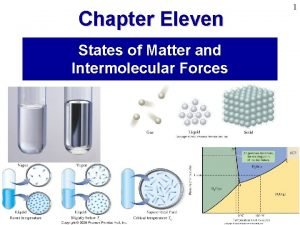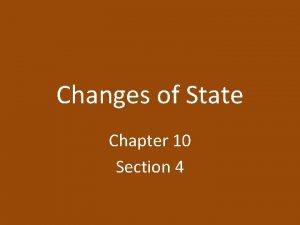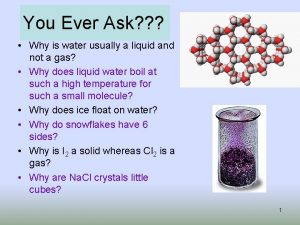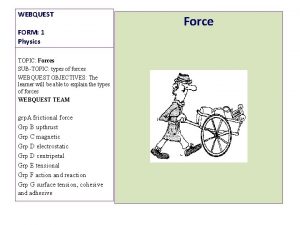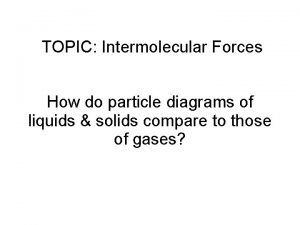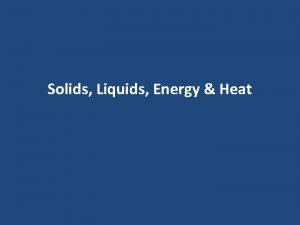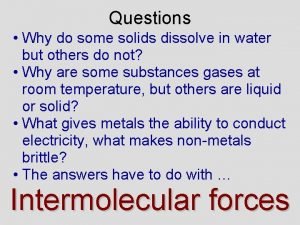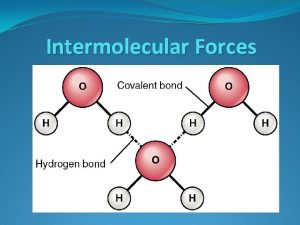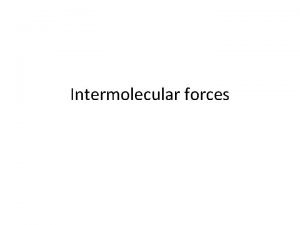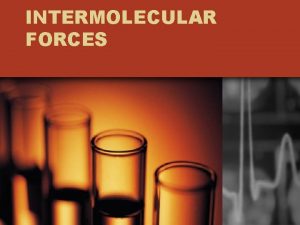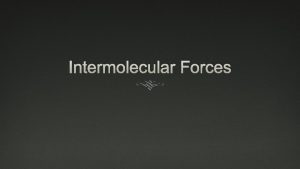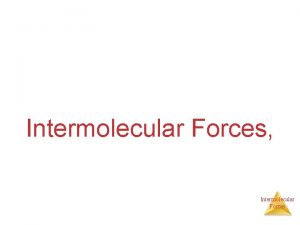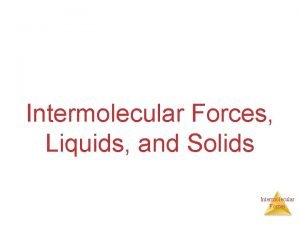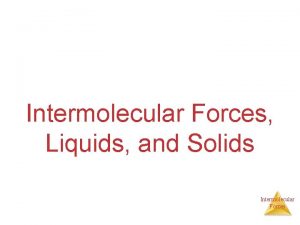Intermolecular Forces Section 7 7 States of Matter

















- Slides: 17

Intermolecular Forces Section 7. 7

States of Matter • Solids and liquids cannot be categorized by a series of laws likes gases • This is due to the forces between the particles • These forces were practically nonexistent for gases, particles were too far apart moving at too fast a speed • These forces are much stronger for solids and liquids because the particles are closer together

Intermolecular Forces • Intermolecular forces: attractive forces that exist between molecules • Also known as IMF • Three types of IMF in covalent molecules • Strength of IMF dependent of polarity of molecule and types of bonds

Intermolecular Forces • Three IMF in order of increasing strength • London Dispersion Forces • Dipole-dipole Interactions • Hydrogen Bonding o A bit of a misnomer as there is no actual bonding taking place • Strength of IMF determines physical properties o Melting point, boiling point, solubility

London Dispersion Forces • Very weak interactions between molecules due to the instantaneous changes in electron density in a molecule London dispersion forces dd- d+ d+ d- d+

London Dispersion Forces • The larger the molecule, the larger the attractive force between the two molecules, and the stronger the intermolecular force • Dominant force in nonpolar molecules • Found between all molecules • London Dispersion Forces also known as dispersion forces, Van der Waals forces, LDF

Dipole-dipole Interactions • Attractive forces between the permanent dipoles of two polar molecules • Found in all polar molecules Dipole-dipole interactions H O H C d+ d-

Hydrogen Bonding • Attractive forces when a hydrogen atom bonded to N, O, or F is attracted to an N, O, or F in another molecule • Dominant force is polar molecules with H bonded to N, O, or F H O H-bonding H

Summary Type of Force Relative Strength Exhibited By Example London dispersion weak all molecules CH 4, H 2 CO, H 2 O Dipole-dipole moderate polar molecules H 2 CO, H 2 O strong polar molecules with an O—H, N —H, or F—H bond H-bonding H 2 O

Example #1 What types of intermolecular forces are present in each molecule? a. b. c. d. e. Cl 2 HCN HF CH 3 Cl H 2

Example #1 Solved a. Cl 2: nonpolar molecule; LDF b. HCN: polar molecule; LDF, dipole-dipole interactions c. HF: polar molecule with H bonded to F; LDF, dipole, H-bonding d. CH 3 Cl: polar molecule; LDF, dipole-dipole e. H 2: nonpolar molecule; LDF

Physical Properties • Dependent on strength of intermolecular forces • Boiling point and melting point o Bp and mp • The stronger the IMF, the higher the boiling point and melting points Compounds with LDF only Compounds with dipole-dipole Compounds that can hydrogen bond Increasing strength of intermolecular forces Increasing boiling point Increasing melting point

Physical Properties C H H H London forces only bp = -162°C mp = -183°C H O H H Hydrogen bonding bp = 100°C mp = 0°C Stronger forces higher bp and mp

Example #2 Which compound in each pair has a higher boiling point? Which compound in each pair has the higher melting point? a. CH 4 or C 2 H 6 b. C 2 H 6 or CH 3 OH c. HBr or HCl

Example #2 Solved Whichever compound has higher boiling point will have higher melting point a. CH 4 or C 2 H 6 Both nonpolar compounds, larger compound will have higher bp/mp b. C 2 H 6 or CH 3 OH is polar and has H bonded to O c. HBr or HCl Both polar, larger compound will have higher mp/bp

Example #3 Which of the compounds in each pair has stronger intermolecular forces? a. CO 2 or H 2 O b. CO 2 or HBr c. HBr or H 2 O

Example #4 Explain why CO 2 is a gas at room temperature but H 2 O is a liquid.
 Intermolecular vs intramolecular forces
Intermolecular vs intramolecular forces Intermolecular forces ranked
Intermolecular forces ranked Covalent bond intermolecular forces
Covalent bond intermolecular forces Intermolecular force
Intermolecular force Section 1 composition of matter
Section 1 composition of matter Chapter 10 review states of matter section 4
Chapter 10 review states of matter section 4 Composition of matter section 1
Composition of matter section 1 Chapter 2 section 1 classifying matter answer key
Chapter 2 section 1 classifying matter answer key Section 1 composition of matter
Section 1 composition of matter London dispersion forces induced dipole
London dispersion forces induced dipole Force and motion webquest
Force and motion webquest Imf
Imf 3 types of intermolecular forces
3 types of intermolecular forces Concept of imfa
Concept of imfa Factors affecting solvation worksheet answers
Factors affecting solvation worksheet answers Induced dipole
Induced dipole Phthatic
Phthatic Intermolecular forces in formaldehyde
Intermolecular forces in formaldehyde



